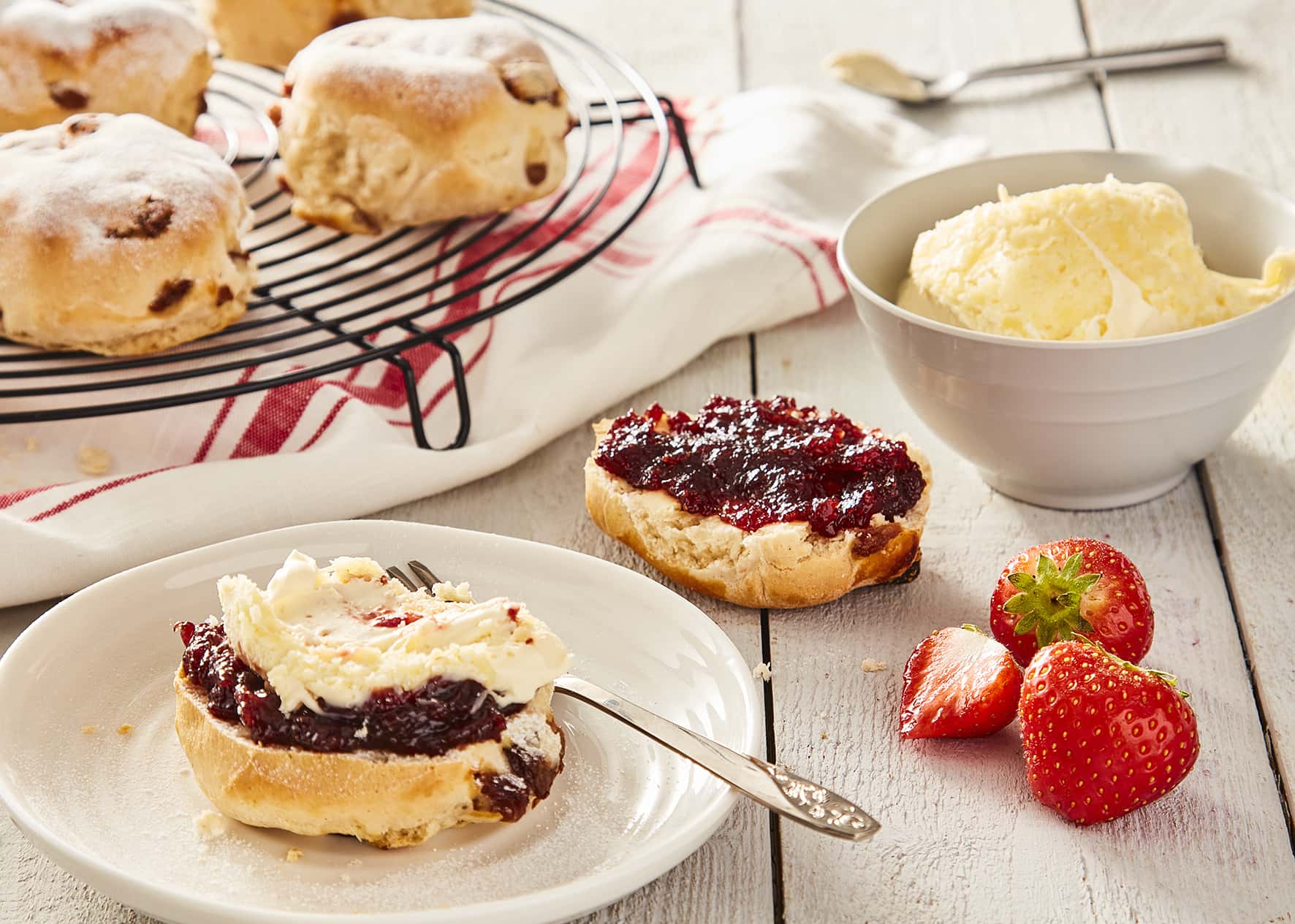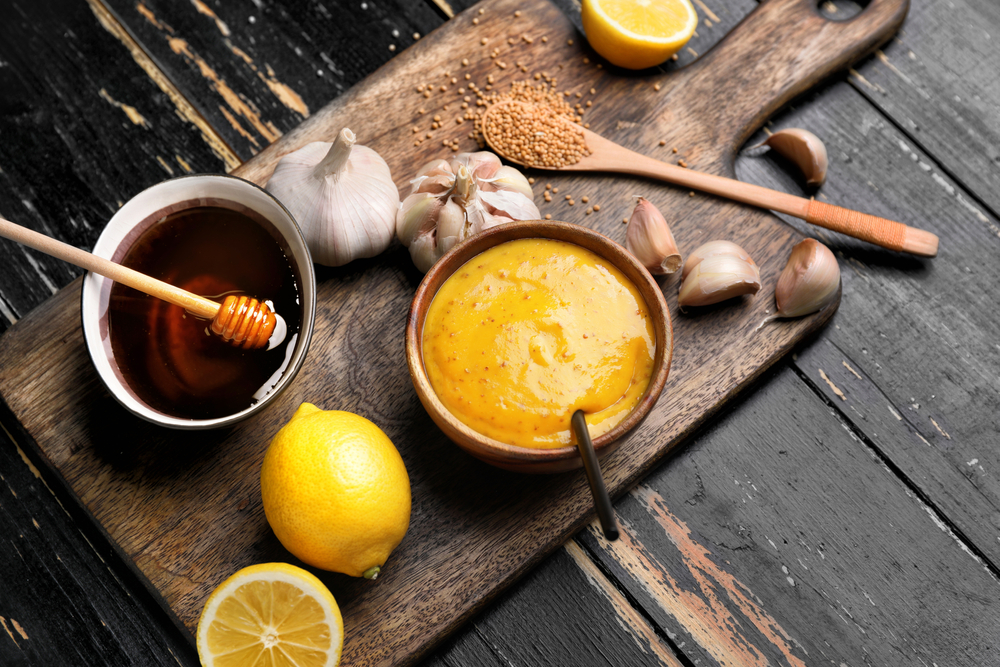The difference between clotted cream and crème fraîche


Are clotted cream and crème fraîche the same thing? It’s a question that many people have probably pondered over a nice scone or maybe even creamy pasta dish. And, while both are made with heavy cream, they are in fact quite different. As a result, each will lend its own distinctive character when used as a spread or garnish for a host of savoury and sweet dishes.

What is clotted cream?
Clotted cream is a thick and creamy spread that’s smooth in texture and has a thin and light yellow crust. It has a lightly caramelised milky taste that is similar to butter. Clotted cream is traditionally thick, silky and luxurious in texture. It originated in southwest England – especially in the English counties of Devon and Cornwall where it is serious business.
Traditional clotted cream is made with full fat, unpasteurised cow’s milk, and authentic clotted cream contains about 55% of butterfat. The production of clotted cream involves heating milk for many hours until the cream rises and forms clots. Originally, this method of production was in use to keep the milk longer without spoiling.
Clotted cream is usually eaten spread on scones together with jam, especially at afternoon tea. The scones are sliced in half and a generous amount of clotted cream is spread on each half. It’s also used in a variety of sweet baked treats.


Our Classic Clotted Cream.
Thick and creamy, it’s absolutely dreamy on scones warm from the oven. Clotted cream, jam and scones have always been our favourite part of afternoon tea.
Our rich and creamy clotted cream is a British classic. It’s created in small batches and has an authentically smooth texture and taste. Serve on warm homemade scones along with Cottage Delight Strawberry Whole Fruit Jam for a great afternoon tea experience.
Try this quintessentially British classic with our recipe for the Perfect Classic Scones.
What is crème fraîche?
Crème fraîche is a type of soured cream often used as a classic ingredient in cuisine from France, where it originated.
Although it looks like sour cream, it’s richer, thicker and less tangy. The cream used for crème fraîche has at least a 30% fat content, which makes it creamier and thicker. And being less prone to curdling when simmering, it’s good for cooking too.
A versatile ingredient, you can use crème fraîche in both sweet and savoury dishes. You can serve it raw or heated, spoon it over fresh fruits like strawberries or with cooked vegetables, or use it as a garnish for soups. Basically, you can use crème fraîche anywhere you might use sour cream.
What’s the different between clotted cream & crème fraîche?
Clotted cream and crème fraîche are both dairy products that are popular in European cuisine. Both are made with heavy cream and contain a high fat content.


The main difference between clotted cream and crème fraîche is their method of production. Clotted cream is made by heating full-fat milk until clots form, while crème fraîche is cultivated with bacteria, the same way that cultured dairy products like yogurt and buttermilk are.
Crème fraîche has a sour flavour, giving it a distinctive taste that is very different from that of clotted cream, which has a nutty flavour from being heated and a buttery richness.
It can help to bring additional creaminess to a dish, such as our Chicken, Leek & Potato Pie.
Crème fraîche and clotted cream also react differently to heat. Crème fraîche can be boiled without curdling; like other creams aside from crème fraîche, clotted cream shouldn’t be boiled because it might curdle.
Can I use crème fraîche instead of clotted cream?
Crème fraîche can be used as a clotted cream substitute as a topping for fruit and baked goods as it has a similar thickness and creaminess to that of clotted cream. But considering crème fraîche’s more tangy, sour flavour, it will be a better fit for some recipes than others.
Can I use clotted cream instead of crème fraîche?
Clotted cream’s essential richness makes it a good substitute for fraîche, but not when crème fraîche’s distinctive tart edge is a preferred element. Clotted cream won’t be a good substitute for crème fraîche in dishes where it will be boiled or combined with acids since it might curdle, but it will be an effective substitute as a topping.
When to use crème fraîche, and when to use clotted cream
Use crème fraîche for soups and sauces where you need a creamy element and a thickener because you can boil it with no risk of it curdling. Crème fraîche is also excellent in scrambled eggs, salad dressings and as a topping.
Clotted cream is traditionally used as a spread for scones and Devonshire splits where it is usually paired with jam, but you can use it alone on fruit. It’s great on waffles and pancakes and makes a good cake frosting.



In the duel of the dairy, clotted cream and crème fraîche may appear to be similar due to their high fat content and creamy texture, but they are quite distinct in their flavour, production methods and usage. Crème fraîche is great for soups, sauces, scrambled eggs, salad dressings, and toppings, while clotted cream is perfect for scones, baked treats, and even as a cake frosting. Enjoy!
PRODUCTS USED IN THIS BLOG
If you don’t have any of the key Cottage Delight ingredients but love the recipe, perhaps you have one of these tasty alternatives in your kitchen cupboards instead?
Other blogs you might like to read





